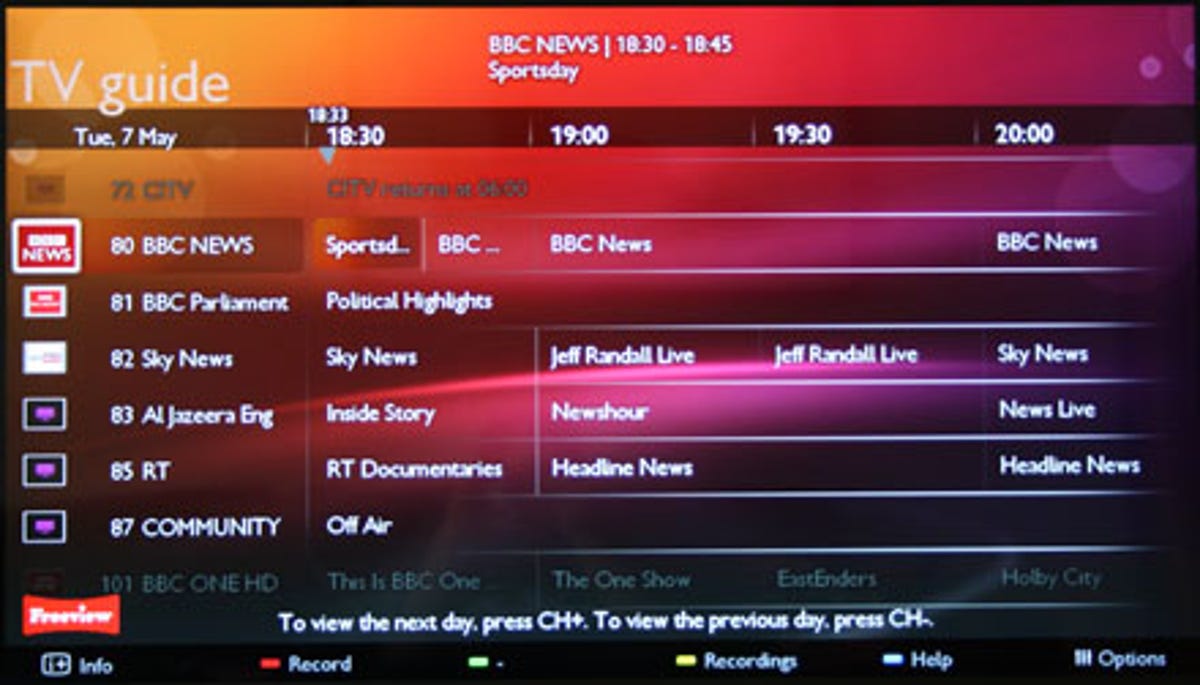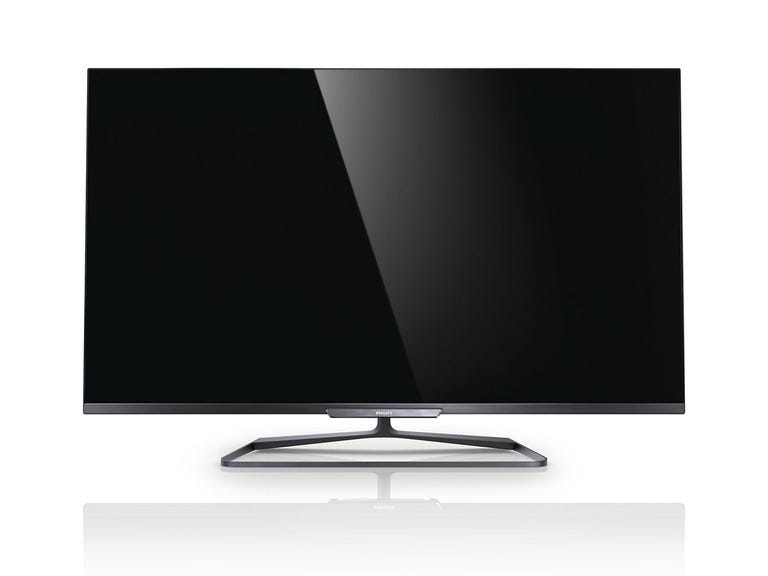 Why You Can Trust CNET
Why You Can Trust CNET Philips 47PFL6008 review: Philips 47PFL6008
The Philips 47PFL6008 benefits from an attractive design, strong audio quality and sharp HD pictures.
Philips TV division has been through a series of changes recently. It's been partitioned off from the main company and is now operated as a join venture by Philips and Chinese firm TPV Technology. The 47PFL6008 is the latest fruit of this partnership.
The Good
The Bad
The Bottom Line
Despite being a mid-range TV, it's packed with features including passive 3D support, Philips's Ambilight system and 500Hz motion processing. Its £1,200 asking price means, however, that it has plenty of competition from big-name TV brands like Panasonic, Samsung and Sony.
User interface and EPG
The 47PFL6008 benefits from the redesigned Philips TV interface. It's more straightforward to use, as it's now centred around a scrolling banner of icons that you use to access the TV's main functions, such as the settings menu, AV inputs and the smart TV service.

It looks relatively slick and there are some neat touches, such as the way the TV is able to automatically label HDMI inputs with the names of the kit you've got attached to them. Despite the fact the TV uses a dual-core processor though, the menu system feels a good deal more sluggish than the systems on the latest Samsung and Panasonic TVs, which whizz along speedily in comparison. Navigation of the menu system is on the clunky side, with the result that it takes longer than it should to adjust picture or audio settings.
The EPG is also a mixed bag. The design is pleasant to look at and the layout is unfussy. Programming data is laid out across a traditional horizontal bricks-in-the-wall style grid, and it's pretty easy to jump around channels and shows in the grid via the remote. Actually using the EPG is pretty intrusive though. It lacks the video window that most other manufacturers have now integrated into their EPGs, so when you call it up it stops all audio and video from the channel you were just watching.
It's also worth noting that although the 47PFL6008 has a HD satellite tuner sitting alongside its Freeview HD tuner, it isn’t currently Freesat compatible. As such, it really isn't terribly useful for UK satellite channels, with the EPG not supporting them properly and presenting a jumbled list of channels in no particular order after tuning. Philips says it's in discussion with Freesat, but hasn’t given a timeline or a definite answer as to whether Freesat will be added to the TV.
Digital media and Internet features
Smart TV is the major battle ground in TV land at the moment. Unfortunately, Philips isn't bearing up all that well in this scrap. It's struggled to keep pace, and despite a major redesign its system is still a long way off what you'd find on rival platforms, such as those from Panasonic and Samsung.
The smart TV system is at least easy to use. It presents you with two pages of apps below a video thumbnail window of the chosen AV source. Next to this there's a box that show some suggested online content that you might want to check out.
There are apps for video-on-demand services such as Blinkbox and Acetrax, as well as BBC iPlayer, Viewster and YouTube. A social media app is included too, overlaying Twitter and Facebook feeds on the top of the live TV stream. Naturally the TV also has an app store where you can download a few extra apps, such as Ebay and TomTom HD.
The remote that comes with this set has a full Qwerty keyboard on the rear. It comes in handy when you need to enter addresses in the simple Web browser or login details for the likes of Facebook. That said, the Facebook app is actually disappointingly basic and slighty buggy.
The app store is also barren compared to those found on Samsung and LG TVs. The lineup of available catch-up services is similarly poor, and it doesn't support ITV Player, 4oD and Demand 5. Netflix isn't currently available either and neither is Lovefilm. In comparison, all of these are now on Samsung's platform.
The smart TV system also feels very sluggish to use. When you open up the menu it can take several seconds just for the icons to appear on the screen. To speak plainly, if you think you're going to want to use a bunch of online video services, this is not the TV for you.
Philips does have a remote control app available for iOS and Android devices that lets you stream from the TV's tuner to your mobile device. This works well, although the TV only has one tuner so you can only stream the channel the TV is tuned to.
Naturally this model also has digital media playback features and these, thankfully, are pretty impressive. It'll happily play back MKV HD files as well as MP4, Xvid and WMV videos either from USB drives or across a network from DLNA devices like PCs and networked hard drives. The transport controls work well when you're streaming files too, unlike Samsung's current TVs.
Design and connections
Philips has a knack for turning out good looking sets, something that most definitely hasn’t changed with this model. The most striking element of its design is just how narrow the bezel is. In fact, with the TV turned off it looks like there's hardly any bezel at all. The screen surface seems to just extend from edge to edge, with only a thin metal strip running around the outer edge. When you turn it on though, you can see that there's actually a very narrow piano black strip around the screen, but this only measures 11mm, so even when the set is turned on it still looks relatively frameless.
Philips tends to use quality material for its TVs' chassis -- as is the case here. The thin, elegant pedestal stand is made from metal rather than plastic, and there's also a brushed metal strip across the lower section of the bezel inset into which is the Philips logo. It all helps to make this telly look like a quality offering.
It's not lacking on the connection front either. The various inputs are split between a downward-facing panel on the rear and a side-mounted panel inset from the left-hand edge of the TV. The rear panel houses three HDMI sockets, with a fourth on the side-mounted panel. The side panel also houses the TV's three USB ports, while the rear panel has an AV mini port for set's Scart adapter, as well as an optical audio output. There are also mini jacks for the composite input mounted on top of the rear panel and facing outwards. Naturally, Wi-Fi and Ethernet are built in.
2D picture quality
When you first switch on the TV, a setup wizard guides you through the process of tuning the channels and connecting to a home network. It then shows you a series of side-by-side image,s asking you to choose which you prefer in order to set up the TV's picture settings. It's a great idea, but unfortunately the results are terrible -- Philips needs to go back to the drawing board with this one.
With some work, however, you can get pretty good pictures out of this TV. You do have to turn down the backlight setting quite significantly to achieve deeper black levels and cut down on blotchiness from the back light bleeding into the picture. This does dim the image though, leaving pictures looking less vibrant than on rival models and robbing images of shadow detail. Nevertheless, the colour palette when working with HD and SD sources has an impressive purity to it, and avoids overstepping the mark in to gaudiness. HD sources also look incredibly sharp too.
The set uses a 100Hz panel and also employs back light blinking to help further smooth motion -- this is where Philips gets the magical 500Hz figure it quotes in its marketing materials. For an LED model its motion handling is quite good, especially if you add in the natural motion processing at its lowest settings. If you jack it up over the minimum setting, you'll start to see a series of picture glitches, such as flickering around moving objects.
This TV also has Philips Ambilight system on board. It uses two lighting strips rather than the three found on the higher-end models, so if you peer around the back you'll see a row of LEDs down the left and right sides of the TV on the rear, but not across the top.
Ambilight projects pools of coloured light onto the wall behind your TV to complement the pictures being displayed onscreen. You can now even tell the system what colour your wall is, so it can adjust the lighting accordingly. The whole thing might sound like a gimmick, but Ambilight actually works very well when you're watching this TV in the evening, with the subtle lighting around the screen helping to suck you into the image.
The main problem with this set, though, is its picture processing. The Philips picture engine is undoubtedly smart, but it's also quite difficult to get good results from it. Often if you set it up to produce crisp pictures for standard-definition broadcasts, HD feeds will look awful, and vice versa. Rival systems from the likes of Sony and Panasonic do a better job across a range of feeds, and so are much less hassle to use than this Philips system.
3D picture quality
This TV is built around an LG panel, so it uses passive rather than active 3D. As a result, it comes with four pairs of passive 3D glasses and if you need more you can buy them for around £2 each.
Passive 3D works by using a polarising filter in front of the screen, which sends alternative lines to the left and right eyes. This does halve the horizontal resolution, but it isn’t all that noticeable from a normal viewing distance. There's also the benefit that passive glasses don’t suffer from flicker and therefore are less tiring on your eyes. They're also lighter and more comfortable to wear.
That's certainly the case here, as the 47PFL6008 produces convincing 3D pictures that are bright and comfortable to watch. There's also a good sense of depth, which makes the 3D effect seem all that more real. You will see some jaggies here and there on angular or circular elements in the picture due to the cut in horizontal resolution, but they're not really that distracting. As with most passive 3D screens, there's virtually no crosstalk visible on this model's 3D pictures either, so overall this is a good set for family 3D viewing.
Audio Quality
Most flatscreen TVs tend to have quite tinny sounding audio, but Philips usually manages to avoid this. That's certainly the case here -- the 47PFL6008's audio has more low-end presence than the vast majority of LED sets that I review. One of the main reasons for this is that Philips has added a mini subwoofer to the rear of the TV, helping it to deliver much more convincing bass. Dialogue sounds very clear and distinct too, but it has to be said that the TV's pseudo-surround modes aren’t much cop, so they're best left turned off.
Conclusion
The 47PFL6008 is a handsome looking TV with a number of strengths, including good sound quality and sharp HD pictures. There's plenty of competition at this price point, however, and Philips struggles to keep pace due to its below par smart TV system and difficult-to-use picture processing.
At the end of the day, I can't help feeling the likes of Panasonic's TX-L47ET60B would be a better option for most people, despite the fact that its sound quality isn’t as good as this model's.


